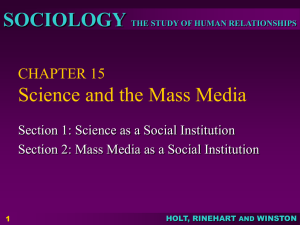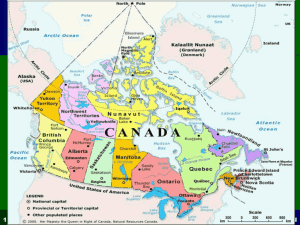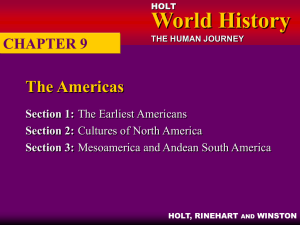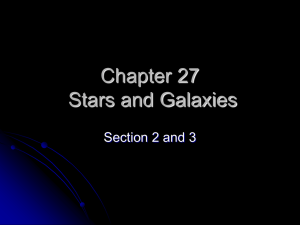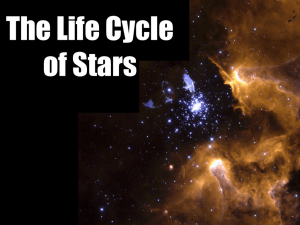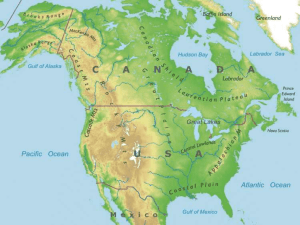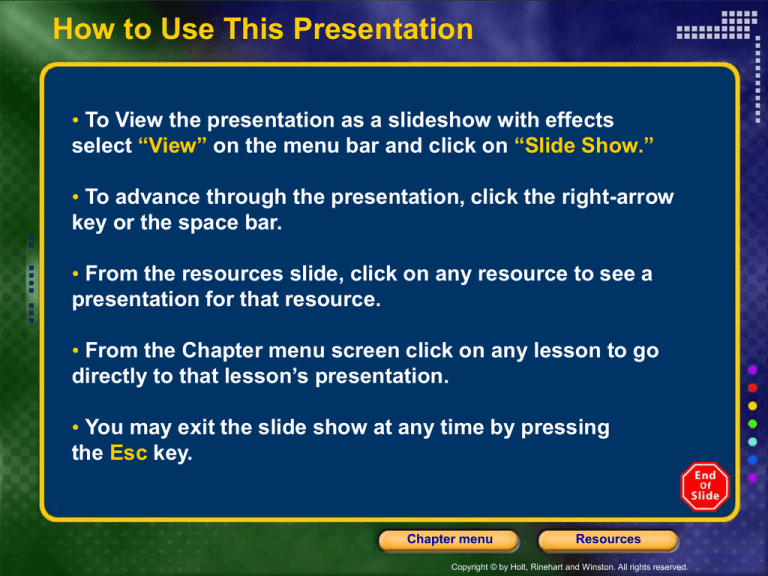
How to Use This Presentation
• To View the presentation as a slideshow with effects
select “View” on the menu bar and click on “Slide Show.”
• To advance through the presentation, click the right-arrow
key or the space bar.
• From the resources slide, click on any resource to see a
presentation for that resource.
• From the Chapter menu screen click on any lesson to go
directly to that lesson’s presentation.
• You may exit the slide show at any time by pressing
the Esc key.
Chapter menu
Resources
Copyright © by Holt, Rinehart and Winston. All rights reserved.
Resources
Chapter Presentation
Transparencies
Visual Concepts
Standardized Test Prep
Brain Food Video Quiz
Chapter menu
Resources
Copyright © by Holt, Rinehart and Winston. All rights reserved.
Chapter 30
Stars, Galaxies, and the Universe
Table of Contents
Section 1 Characterstics of Stars
Section 2 Stellar Evolution
Section 3 Star Groups
Section 4 The Big Bang Theory
Chapter menu
Resources
Copyright © by Holt, Rinehart and Winston. All rights reserved.
Chapter 30
Section 1 Characteristics of
Stars
Objectives
• Describe how astronomers determine the
compositions and temperature of stars.
• Explain why stars appear to move in the sky.
• Describe one way astronomers measure the
distances to stars.
• Explain the difference between absolute magnitude
and apparent magnitude.
Chapter menu
Resources
Copyright © by Holt, Rinehart and Winston. All rights reserved.
Chapter 30
Section 1 Characteristics of
Stars
Analyzing Starlight
star a large celestial body that is composed of gas and
that emits light.
• Nuclear fusion is the combination of light atomic
nuclei to form heavier atomic nuclei
• Astronomers learn about stars by analyzing the light
that the stars emit.
• Starlight passing through a spectrograph produces a
display of colors and lines called a spectrum.
Chapter menu
Resources
Copyright © by Holt, Rinehart and Winston. All rights reserved.
Chapter 30
Section 1 Characteristics of
Stars
Analyzing Starlight, continued
• All stars have dark-line spectra, which are bands of
color crossed by dark lines where the color is
diminished.
• A star’s dark-line spectrum reveals the star’s
composition and temperature.
• Stars are made up of different elements in the form of
gases.
• Because different elements absorb different
wavelengths of light, scientists can determine the
elements that make up a star by studying its
spectrum.
Chapter menu
Resources
Copyright © by Holt, Rinehart and Winston. All rights reserved.
Chapter 30
Section 1 Characteristics of
Stars
The Compositions of Stars
• Scientists have learned that stars are made up of the
same elements that compose Earth.
• The most common element in stars is hydrogen.
• Helium is the second most common element in star.
• Small quantities of carbon, oxygen, and nitrogen are
also found in stars.
Chapter menu
Resources
Copyright © by Holt, Rinehart and Winston. All rights reserved.
Chapter 30
Section 1 Characteristics of
Stars
The Temperatures of Stars
• The temperature of most stars ranges from 2,800˚C
to 24,000˚C.
• Blue stars have average surface temperatures of
35,000˚C.
• Yellow stars, such as the sun, have surface
temperatures of about 5,500˚C.
• Red stars have average surface temperatures of
3,000˚C.
Chapter menu
Resources
Copyright © by Holt, Rinehart and Winston. All rights reserved.
Chapter 30
Section 1 Characteristics of
Stars
The Sizes and Masses of Stars
• Stars vary in size and mass.
• Stars such as the sun are considered medium-sized
stars. The sun has a diameter of 1,390,000 km.
• Most stars visible from Earth are medium-sized stars.
• Many stars also have about the same mass as the
sun, however some stars may be more or less
massive.
Chapter menu
Resources
Copyright © by Holt, Rinehart and Winston. All rights reserved.
Chapter 30
Section 1 Characteristics of
Stars
Stellar Motion
Apparent Motion
• The apparent motion of stars is the motion visible to
the unaided eye. Apparent motion is caused by the
movement of Earth.
• The rotation of Earth causes the apparent motion of
stars sees as though the stars are moving counterclockwise around the North Star.
• Earth’s revolution around the sun causes the stars to
appear to shift slightly to the west every night.
Chapter menu
Resources
Copyright © by Holt, Rinehart and Winston. All rights reserved.
Chapter 30
Section 1 Characteristics of
Stars
Stellar Motion, continued
Reading Check
Why does Polaris appear to remain stationary in the
night sky?
Chapter menu
Resources
Copyright © by Holt, Rinehart and Winston. All rights reserved.
Chapter 30
Section 1 Characteristics of
Stars
Stellar Motion, continued
Reading Check
Why does Polaris appear to remain stationary in the
night sky?
Polaris is almost exactly above the pole of Earth’s
rotational axis, so Polaris moves only slightly around
the pole during one rotation of Earth.
Chapter menu
Resources
Copyright © by Holt, Rinehart and Winston. All rights reserved.
Chapter 30
Section 1 Characteristics of
Stars
Stellar Motion, continued
Circumpolar Stars
• Some stars are always visible in the night sky. These
stars never pass below the horizon.
• In the Northern Hemisphere, the movement of these
stars makes them appear to circle the North Star.
• These circling stars are called circumpolar stars.
Chapter menu
Resources
Copyright © by Holt, Rinehart and Winston. All rights reserved.
Chapter 30
Section 1 Characteristics of
Stars
Stellar Motion, continued
Actual Motion of Stars
• Most stars have several types of actual motion.
• Stars rotate on an axis.
• Some stars may revolve around another star.
• Stars either move away from or toward our solar
system.
Chapter menu
Resources
Copyright © by Holt, Rinehart and Winston. All rights reserved.
Chapter 30
Section 1 Characteristics of
Stars
Stellar Motion, continued
Actual Motion of Stars
• Doppler effect an observed change in the frequency of a wave
when the source or observer is moving
• The spectrum of a star that is moving toward or away from Earth
appears to shift, due to the Doppler effect.
• Stars moving toward Earth are shifted slightly toward blue,
which is called blue shift.
• Stars moving away from Earth are shifted slightly toward red,
which is called red shift.
Chapter menu
Resources
Copyright © by Holt, Rinehart and Winston. All rights reserved.
Chapter 30
Section 1 Characteristics of
Stars
Stellar Motion, continued
The spectrum of a star that is moving toward or away from Earth appears
to shift, as shown in the diagram below.
Chapter menu
Resources
Copyright © by Holt, Rinehart and Winston. All rights reserved.
Chapter 30
Section 1 Characteristics of
Stars
Distances to Stars
• light-year the distance that light travels in one year.
• Distances between the stars and Earth are measured in lightyears.
• parallax an apparent shift in the position of an object when
viewed from different locations.
• For relatively close stars, scientists determine a star’s distance
by measuring parallax.
Chapter menu
Resources
Copyright © by Holt, Rinehart and Winston. All rights reserved.
Chapter 30
Section 1 Characteristics of
Stars
Light-Year
Chapter menu
Resources
Copyright © by Holt, Rinehart and Winston. All rights reserved.
Chapter 30
Section 1 Characteristics of
Stars
Stellar Brightness
• Apparent magnitude the brightness of a star as seen from the
Earth.
• The apparent magnitude of a star depends on both how much
light the star emits and how far the star is from Earth.
• Absolute magnitude the brightness that a star would have at a
distance of 32.6 light-years from Earth
• The brighter a star is, the lower the number of its absolute
magnitude.
Chapter menu
Resources
Copyright © by Holt, Rinehart and Winston. All rights reserved.
Chapter 30
Section 1 Characteristics of
Stars
Stellar Brightness
The lower the number of the star on the scale shown on the diagram
below, the brighter the star appears to observers.
Chapter menu
Resources
Copyright © by Holt, Rinehart and Winston. All rights reserved.
Chapter 30
Section 1 Characteristics of
Stars
Absolute and Apparent Motion
Chapter menu
Resources
Copyright © by Holt, Rinehart and Winston. All rights reserved.
Chapter 30
Section 2 Stellar Evolution
Objectives
• Describe how a protostar becomes a star.
• Explain how a main-sequence star generates
energy.
• Describe the evolution of a star after its mainsequence stage.
Chapter menu
Resources
Copyright © by Holt, Rinehart and Winston. All rights reserved.
Chapter 30
Section 2 Stellar Evolution
Classifying Stars
• Main sequence the location on the H-R diagram where most
stars lie; it has a diagonal pattern from the lower right to the
upper left.
• One way scientists classify stars is by plotting the surface
temperatures of stars against their luminosity. The H-R diagram
is the graph that illustrates the resulting pattern.
• Astronomers use the H-R diagram to describe the life cycles of
stars. Most stars fall within a band that runs diagonally through
the middle of the H-R diagram. These stars are main sequence
stars.
Chapter menu
Resources
Copyright © by Holt, Rinehart and Winston. All rights reserved.
Chapter 30
Section 2 Stellar Evolution
Classifying Stars, continued
• Main sequence the location on the H-R diagram where most
stars lie; it has a diagonal pattern from the lower right to the
upper left.
• One way scientists classify stars is by plotting the surface
temperatures of stars against their luminosity. The H-R diagram
is the graph that illustrates the resulting pattern.
• Astronomers use the H-R diagram to describe the life cycles of
stars. Most stars fall within a band that runs diagonally through
the middle of the H-R diagram. These stars are main sequence
stars.
Chapter menu
Resources
Copyright © by Holt, Rinehart and Winston. All rights reserved.
Chapter 30
Section 2 Stellar Evolution
Classifying Stars, continued
Chapter menu
Resources
Copyright © by Holt, Rinehart and Winston. All rights reserved.
Chapter 30
Section 2 Stellar Evolution
Star Formation
• nebula a large cloud of gas and dust in interstellar space; a
region in space where stars are born.
• A star beings in a nebula. When the nebula is compressed,
some of the particles move close to eaother and are pulled
together by gravity.
• As described in Newton’s law of universal gravitation, as gravity
pulls particles of the nebula closer together, the gravitational pull
of the particles on each other increases.
• As more particles come together, regions of dense matter begin
to build up within the cloud.
Chapter menu
Resources
Copyright © by Holt, Rinehart and Winston. All rights reserved.
Chapter 30
Section 2 Stellar Evolution
Star Formation, continued
Protostars
• As gravity makes dense regions within a nebula more compact,
these regions spin and shrink and begin to form a flattened
disk.The disk has a central concentration of matter called a
protostar.
• The protostar continues to contract and increase in temperature
for several million years. Eventually the gas in the region
becomes so hot that its electrons are stripped from their parent
atoms.
• The nuclei and free electrons move independently, and the gas
is then considered a separate state of matter called plasma.
Chapter menu
Resources
Copyright © by Holt, Rinehart and Winston. All rights reserved.
Chapter 30
Section 2 Stellar Evolution
Star Formation, continued
The Birth of a Star
• A protostar’s temperature continually increases until it reaches
about 10,000,000°C.
• At this temperature, nuclear fusion begins. Nuclear fusion is a
process in which less-massive atomic nuclei combine to form
more-massive nuclei. The process releases enormous amounts
of energy.
• The onset of nuclear fusion marks the birth of a star. Once this
process begins, it can continue for billions of years.
Chapter menu
Resources
Copyright © by Holt, Rinehart and Winston. All rights reserved.
Chapter 30
Section 2 Stellar Evolution
Star Formation, continued
A Delicate Balancing Act
• As gravity increases the pressure on the matter within the star,
the rate of fusion increase.
• In turn, the energy radiated from fusion reactions heats the gas
inside the star.
• The outward pressures of the radiation and the hot gas resist
the inward pull of gravity.
• This equilibrium makes the star stable in size.
Chapter menu
Resources
Copyright © by Holt, Rinehart and Winston. All rights reserved.
Chapter 30
Section 2 Stellar Evolution
Star Formation, continued
Reading Check
How does the pressure from fusion and hot gas interact
with the force of gravity to maintain a star’s stability?
Chapter menu
Resources
Copyright © by Holt, Rinehart and Winston. All rights reserved.
Chapter 30
Section 2 Stellar Evolution
Star Formation, continued
Reading Check
How does the pressure from fusion and hot gas interact
with the force of gravity to maintain a star’s stability?
The forces balance each other and keep the star in
equilibrium. As gravity increases the pressure on the
matter within a star, the rate of fusion increases. This
increase in fusion causes a rise in gas pressure. As a
result, the energy from the increased fusion and gas
pressure generates outward pressure that balances
the force of gravity.
Chapter menu
Resources
Copyright © by Holt, Rinehart and Winston. All rights reserved.
Chapter 30
Section 2 Stellar Evolution
The Main-Sequence Stage
• The second and longest stage in the life of a star is
the main-sequence stage. During this stage, energy
continues to be generated in the core of the star as
hydrogen fuses into helium.
• A star that has a mass about the same as the sun’s
mass stays on the main sequence for about 10 billion
years.
• Scientists estimate that over a period of almost 5
billion years, the sun has converted only 5% of its
original hydrogen nuclei into helium nuclei.
Chapter menu
Resources
Copyright © by Holt, Rinehart and Winston. All rights reserved.
Chapter 30
Section 2 Stellar Evolution
Leaving the Main Sequence
Giant Stars
giant a very large and bright star whose hot core has
used most of its hydrogen.
• A star enters its third stage when almost all of the
hydrogen atoms within its core have fused into
helium atoms. billion years.
• A star’s shell of gases grows cooler as it expands. As
the gases in the outer shell become cooler, they
begin to glow with a reddish color. These stars are
known as giants.
Chapter menu
Resources
Copyright © by Holt, Rinehart and Winston. All rights reserved.
Chapter 30
Section 2 Stellar Evolution
Leaving the Main Sequence, continued
Supergiants
• Main-sequence stars that are more massive than the
sun will become larger than giants in their third stage.
• These highly luminous stars are called supergiants.
These stars appear along the top of the H-R diagram.
Chapter menu
Resources
Copyright © by Holt, Rinehart and Winston. All rights reserved.
Chapter 30
Section 2 Stellar Evolution
Leaving the Main Sequence, continued
Reading Check
Where are giants and supergiants found on the H-R
diagram?
Chapter menu
Resources
Copyright © by Holt, Rinehart and Winston. All rights reserved.
Chapter 30
Section 2 Stellar Evolution
Leaving the Main Sequence, continued
Reading Check
Where are giants and supergiants found on the H-R
diagram?
Giants and supergiants appear in the upper right part of
the H-R diagram.
Chapter menu
Resources
Copyright © by Holt, Rinehart and Winston. All rights reserved.
Chapter 30
Section 2 Stellar Evolution
The Final Stages of a Sunlike Star
Planetary Nebulas
• As the star’s outer gases drift away, the remaining
core heats these expanding gases.
• The gases appear as a planetary nebula, a cloud of
gas that forms around a sunlike star that is dying.
Chapter menu
Resources
Copyright © by Holt, Rinehart and Winston. All rights reserved.
Chapter 30
Section 2 Stellar Evolution
The Final Stages of a Sunlike Star, continued
White Dwarfs
• As a planetary nebula disperses, gravity causes the remaining
matter in the star to collapse inward.
• The matter collapses until it cannot be pressed further together.
• A hot, extremely dense core of matter - a white dwarf - is left.
White dwarfs shine for billions of years before they cool
completely.
• The gases appear as a planetary nebula, a cloud of gas that
forms around a sunlike star that is dying.
Chapter menu
Resources
Copyright © by Holt, Rinehart and Winston. All rights reserved.
Chapter 30
Section 2 Stellar Evolution
The Final Stages of a Sunlike Star, continued
Novas and Supernovas
nova a star that suddenly becomes brighter
• Some white dwarfs revolve around red giants. When this
happeneds, the gravity of the whit dwarf may capture gases
from the red giant.
• As these gases accumulate on the surface of the white dwarf,
pressure begins to build up.
• This pressure may cause large explosions. These explosions
are called novas.
Chapter menu
Resources
Copyright © by Holt, Rinehart and Winston. All rights reserved.
Chapter 30
Section 2 Stellar Evolution
The Final Stages of a Sunlike Star, continued
Novas and Supernovas
• A white dwarf may also become a supernova, which
is a star that has such a tremedous explosion that it
blows itself apart.
• The explosions of supernovas completely destroy the
white dwarf star and may destroy much of the red
giant.
Chapter menu
Resources
Copyright © by Holt, Rinehart and Winston. All rights reserved.
Chapter 30
Section 2 Stellar Evolution
The Final Stages of Massive Stars
Supernovas in Massive Stars
• Massive stars become supernovas as part of their life
cycle.
• After the supergiant stage, the star collapses,
producing such high temperatures that nuclear fusion
begins again.
• When nuclear fusion stops, the star’s core begins to
collapse under its own gravity. This causes the outer
layers to explode outward with tremendous force.
Chapter menu
Resources
Copyright © by Holt, Rinehart and Winston. All rights reserved.
Chapter 30
Section 2 Stellar Evolution
The Final Stages of Massive Stars, continued
Reading Check
What causes a supergiant star to explode as a
supernova?
Chapter menu
Resources
Copyright © by Holt, Rinehart and Winston. All rights reserved.
Chapter 30
Section 2 Stellar Evolution
The Final Stages of Massive Stars, continued
Reading Check
What causes a supergiant star to explode as a
supernova?
Giants and supergiants appear in the upper right part of
the H-R diagram.
Chapter menu
Resources
Copyright © by Holt, Rinehart and Winston. All rights reserved.
Chapter 30
Section 2 Stellar Evolution
The Final Stages of Massive Stars, continued
Neutron Stars
neutron star a star that has collapsed under gravity to
the point that the electrons and protons have
smashed together to form neutrons
• Stars more massive than the sun do not become
white dwarfs.
• After a star explodes as a supernova, the core may
contract into a neutron star.
Chapter menu
Resources
Copyright © by Holt, Rinehart and Winston. All rights reserved.
Chapter 30
Section 2 Stellar Evolution
The Final Stages of Massive Stars, continued
Chapter menu
Resources
Copyright © by Holt, Rinehart and Winston. All rights reserved.
Chapter 30
Section 2 Stellar Evolution
Types of Stars
Chapter menu
Resources
Copyright © by Holt, Rinehart and Winston. All rights reserved.
Chapter 30
Section 2 Stellar Evolution
The Final Stages of Massive Stars, continued
Pulsars
pulsar a rapidly spinning neutron star that emits pulses
of radio and optical energy
• Some neutron stars emit a beam of radio waves that
sweeps across space and are detectable here on
Earth.
• These stars are called pulsars. For each pulse
detected on Earth, we know that the star has rotated
within that period.
Chapter menu
Resources
Copyright © by Holt, Rinehart and Winston. All rights reserved.
Chapter 30
Section 2 Stellar Evolution
The Final Stages of Massive Stars, continued
Black Holes
black hole an object so massive and dense that even
light cannot escape its gravity
• Some massive stars produce leftovers too massive to
become a stable neutron star.
• These stars contract, and the force of the contratction
leaves a black hole.
Chapter menu
Resources
Copyright © by Holt, Rinehart and Winston. All rights reserved.
Chapter 30
Section 3 Star Groups
Objectives
• Describe the characteristics that identify a
constellation.
• Describe the three main types of galaxies.
• Explain how a quasar differs from a typical galaxy.
Chapter menu
Resources
Copyright © by Holt, Rinehart and Winston. All rights reserved.
Chapter 30
Section 3 Star Groups
Constellations
Dividing Up the Sky
constellation one of 88 regions into which the skay has
been divided in order to describe the locations of
celestial objects; a group of stars organized in a
recognizable pattern
• In 1930, astronomers around the world agreed upon
a standard set of 88 constellations.
• You can use a map of the constellations to locate a
particular star.
Chapter menu
Resources
Copyright © by Holt, Rinehart and Winston. All rights reserved.
Chapter 30
Section 3 Star Groups
Constellations, continued
Naming Constellations
• Many of the modern names we use for the
constellations come from Latin.
• Some constellations are named for real or imaginary
animals, such as Ursa Major (the great bear) or
ancient gods or legendary heroes, such as Hercules
or Orion.
Chapter menu
Resources
Copyright © by Holt, Rinehart and Winston. All rights reserved.
Chapter 30
Section 3 Star Groups
Constellations, continued
The Constellation Orion
Chapter menu
Resources
Copyright © by Holt, Rinehart and Winston. All rights reserved.
Chapter 30
Section 3 Star Groups
Multiple-Star Systems
• Over half of all observed stars form multiple-star
systems.
• Binary stars are pairs of stars that revolve around
each other and are held together by gravity. The
center of mass, or barycenter, is somewhere between
the two stars.
• In star systems that have more than two stars, two
stars may revolve rapidly around a common
barycenter, while a third star revolves more slowly at
a greater distance from the pair.
Chapter menu
Resources
Copyright © by Holt, Rinehart and Winston. All rights reserved.
Chapter 30
Section 3 Star Groups
Multiple-Star Systems, continued
Reading Check
What percentage of stars are in multiple-star systems?
Chapter menu
Resources
Copyright © by Holt, Rinehart and Winston. All rights reserved.
Chapter 30
Section 3 Star Groups
Multiple-Star Systems, continued
Reading Check
What percentage of stars are in multiple-star systems?
More than 50% of all stars are in multiple-star systems.
Chapter menu
Resources
Copyright © by Holt, Rinehart and Winston. All rights reserved.
Chapter 30
Section 3 Star Groups
Star Clusters
• Sometimes, nebulas collapse to form groups of
hundreds or thousands of stars called clusters.
• Globular clusters have a spherical shape and can
contain up to 100,000 stars.
• An open cluster is loosely shaped and rarely contains
more than a few hundred stars.
Chapter menu
Resources
Copyright © by Holt, Rinehart and Winston. All rights reserved.
Chapter 30
Section 3 Star Groups
Galaxies
galaxy a collection of stars, dust, and gas bound
together by gravity
• Galaxies are the major building blocks of the
universe. Astronomers estimate that the universe
contains hundreds of billions of galaxies.
• A typical galaxy, such as the Milky Way, has a
diameter of bout 100,000 light-years and may contain
more than 200 billion stars.
Chapter menu
Resources
Copyright © by Holt, Rinehart and Winston. All rights reserved.
Chapter 30
Section 3 Star Groups
Galaxies, continued
Distances to Galaxies
• Giant stars called Cepheid variables brighten and
fade in a regular pattern. Most Cepheids have regular
cycles. The longer the cycle, the brighter the star’s
absolute magnitude.
• Scientists compare the Cepheid’s absolute
magnitude and the Cepheid’s apparent magnitude to
calculate the distance to the Cepheid variable.
• This distance tells scientists the distance to the
galaxy in which the Cepheid is located.
Chapter menu
Resources
Copyright © by Holt, Rinehart and Winston. All rights reserved.
Chapter 30
Section 3 Star Groups
Galaxies, continued
Types of Galaxies
• Galaxies are classified by shape into three main types.
• A spiral galaxy has a nucleus of bright stars and flattened arms
that spiral around the nucleus.
• Elliptical galaxies have various shapes and are extremely bright
in the center and do not have spiral arms.
• An irregular galaxy has no particular shape, and is fairly rich in
dust and gas.
Chapter menu
Resources
Copyright © by Holt, Rinehart and Winston. All rights reserved.
Chapter 30
Section 3 Star Groups
Contents of Galaxies
Chapter menu
Resources
Copyright © by Holt, Rinehart and Winston. All rights reserved.
Chapter 30
Section 3 Star Groups
The Milky Way
• The galaxy in which we live, the Milky Way, is a spiral
galaxy in which the sun is one of hundreds of billions
of stars.
• Two irregular galaxies, the Large Magellanic Cloud
and Small Magellanic Cloud, are our closest
neighbors.
• These three galaxies are called the Local Group.
Chapter menu
Resources
Copyright © by Holt, Rinehart and Winston. All rights reserved.
Chapter 30
Section 3 Star Groups
Quasars
quasar quasi-stellar radio source; a very luminous
object that produces energy at a high rate.
• Quasars appear as points of light, similar to stars.
• Quasars are located in the centers of galaxies that
are distant from Earth.
• Quasars are among the most distant objects that
have been observed from Earth.
Chapter menu
Resources
Copyright © by Holt, Rinehart and Winston. All rights reserved.
Chapter 30
Section 4 The Big Bang Theory
Objectives
• Explain how Hubble’s discoveries lead to an
understanding that the universe is expanding.
• Summarize the big bang theory.
• List evidence for the big bang theory.
Chapter menu
Resources
Copyright © by Holt, Rinehart and Winston. All rights reserved.
Chapter 30
Section 4 The Big Bang Theory
Hubble’s Observations
cosmology the study of the origin, properties,
processes, and evolution of the universe
• Cosmologists and astronomers can use the light
given off by an entire galaxy to create the spectrum
for that galaxy.
• Edwin Hubble used galactic spectra to uncover new
information about our universe.
Chapter menu
Resources
Copyright © by Holt, Rinehart and Winston. All rights reserved.
Chapter 30
Section 4 The Big Bang Theory
Hubble’s Observations, continued
Measuring Red Shifts
• Hubble found that the spectra of galaxies, except for
the few closest to Earth, were shifted toward the red
end of the spectrum.
• Hubble determined the speed at which the galaxies
were moving away from Earth.
• Hubble found that the most distant galaxies showed
the greatest red shift and thus were moving away
from Earth the fastest.
Chapter menu
Resources
Copyright © by Holt, Rinehart and Winston. All rights reserved.
Chapter 30
Section 4 The Big Bang Theory
Hubble’s Observations, continued
The Expanding Universe
• Using Hubble’s observations, astronomers have been
able to determine that the universe is expanding.
• The expanding universe can be thought of as a raisin
cake rising in the oven. If you were able to sit on one
raisin, you would see all the other raisins moving
away from you.
• Similarly, galaxies in the universe are moving farther
away from each other due to the expansion of the
universe.
Chapter menu
Resources
Copyright © by Holt, Rinehart and Winston. All rights reserved.
Chapter 30
Section 4 The Big Bang Theory
The Big Bang Theory
big bang theory the theory that all matter and energy in
the universe was compressed into an extremely small
volume that 3 to 15 billion years ago exploded and
began expanding in all directions
• By the mid-20th century, almost all astronomers and
cosmologists accepted the big bang theory.
Chapter menu
Resources
Copyright © by Holt, Rinehart and Winston. All rights reserved.
Chapter 30
Section 4 The Big Bang Theory
The Big Bang Theory, continued
Reading Check
What does the big bang theory tell us about the early
universe?
Chapter menu
Resources
Copyright © by Holt, Rinehart and Winston. All rights reserved.
Chapter 30
Section 4 The Big Bang Theory
The Big Bang Theory, continued
Reading Check
What does the big bang theory tell us about the early
universe?
All matter and energy in the early universe were
compressed into a small volume at an extremely high
temperature until the temperature cooled and all of
the matter and energy were forced outward in all
directions.
Chapter menu
Resources
Copyright © by Holt, Rinehart and Winston. All rights reserved.
Chapter 30
Section 4 The Big Bang Theory
The Big Bang Theory, continued
Cosmic Background Radiation
cosmic background radiation radiation uniformly
detected from every direction in space; considered a
remnant of the big bang.
• Astronomers believe that cosmic background
radiation formed shortly after the big bang.
• The background radiation has cooled after the big
bang, and is now about 270°C below zero.
Chapter menu
Resources
Copyright © by Holt, Rinehart and Winston. All rights reserved.
Chapter 30
Section 4 The Big Bang Theory
The Big Bang Theory, continued
Ripples in Space
• Maps of cosmic background radiation over the whole
sky show ripples.
• These ripples are irregularities caused by small
fluctuations in the distribution of matter in the early
universe, and may indicate the first stages in the
formation of the universe’s first galaxies.
Chapter menu
Resources
Copyright © by Holt, Rinehart and Winston. All rights reserved.
Chapter 30
Section 4 The Big Bang Theory
The Big Bang Theory, continued
Timeline of the Big Bang
Chapter menu
Resources
Copyright © by Holt, Rinehart and Winston. All rights reserved.
Chapter 30
Section 4 The Big Bang Theory
Big Bang Theory
Chapter menu
Resources
Copyright © by Holt, Rinehart and Winston. All rights reserved.
Chapter 30
Section 4 The Big Bang Theory
Universal Expansion
Chapter menu
Resources
Copyright © by Holt, Rinehart and Winston. All rights reserved.
Chapter 30
Section 4 The Big Bang Theory
A Universe of Surprises
Dark Matter
• Analysis of the ripples in the cosmic background
radiation shows that the matter that humans, the
planets, the stars and the matter between the stars
makes up only 4% of the universe.
• About 23% of the universe is made up of a type of
matter that does not give off light but that has gravity.
This type of matter is called dark matter.
Chapter menu
Resources
Copyright © by Holt, Rinehart and Winston. All rights reserved.
Chapter 30
Section 4 The Big Bang Theory
A Universe of Surprises
Dark Energy
• Most of the universe is made up of an unknown
material called dark energy.
• Scientists think that dark energy acts as a force that
opposes gravity. Many scientists think that some form
of undetectable dark energy is pushing galaxies
apart.
Chapter menu
Resources
Copyright © by Holt, Rinehart and Winston. All rights reserved.
Chapter 30
Maps In Action
Maps In Action
The Milky Way
Chapter menu
Resources
Copyright © by Holt, Rinehart and Winston. All rights reserved.
Chapter 30
Stars, Galaxies, and the Universe
Brain Food Video Quiz
Chapter menu
Resources
Copyright © by Holt, Rinehart and Winston. All rights reserved.
Chapter 30
Standardized Test Prep
Multiple Choice
1. What accounts for different stars being seen in the
sky during different seasons of the year?
A. Stellar motion around Polaris
B. Earth’s rotation on its axis
C. Earth’s revolution around the sun
D. Position north or south of the equator
Chapter menu
Resources
Copyright © by Holt, Rinehart and Winston. All rights reserved.
Chapter 30
Standardized Test Prep
Multiple Choice, continued
1. What accounts for different stars being seen in the
sky during different seasons of the year?
A. Stellar motion around Polaris
B. Earth’s rotation on its axis
C. Earth’s revolution around the sun
D. Position north or south of the equator
Chapter menu
Resources
Copyright © by Holt, Rinehart and Winston. All rights reserved.
Chapter 30
Standardized Test Prep
Multiple Choice, continued
2. How do stellar spectra provide evidence that stars
are actually moving?
F.
G.
H.
I.
Dark line spectra reveal a star’s composition.
Long exposure photos show curved trails.
Light separates into different wavelengths.
Doppler shifts occur in the star’s spectrum.
Chapter menu
Resources
Copyright © by Holt, Rinehart and Winston. All rights reserved.
Chapter 30
Standardized Test Prep
Multiple Choice, continued
2. How do stellar spectra provide evidence that stars
are actually moving?
F.
G.
H.
I.
Dark line spectra reveal a star’s composition.
Long exposure photos show curved trails.
Light separates into different wavelengths.
Doppler shifts occur in the star’s spectrum.
Chapter menu
Resources
Copyright © by Holt, Rinehart and Winston. All rights reserved.
Chapter 30
Standardized Test Prep
Multiple Choice, continued
3. What happens to main sequence stars when energy
from fusion is no longer available?
A.
B.
C.
D.
They expand and become supergiants.
They collapse and become white dwarfs.
They switch to fission reactions.
They contract and turn into neutron stars.
Chapter menu
Resources
Copyright © by Holt, Rinehart and Winston. All rights reserved.
Chapter 30
Standardized Test Prep
Multiple Choice, continued
3. What happens to main sequence stars when energy
from fusion is no longer available?
A.
B.
C.
D.
They expand and become supergiants.
They collapse and become white dwarfs.
They switch to fission reactions.
They contract and turn into neutron stars.
Chapter menu
Resources
Copyright © by Holt, Rinehart and Winston. All rights reserved.
Chapter 30
Standardized Test Prep
Multiple Choice, continued
4. Which type of star is most likely to be found on the
main sequence?
F.
G.
H.
I.
a white dwarf
a red supergiant
a yellow star
a neutron star
Chapter menu
Resources
Copyright © by Holt, Rinehart and Winston. All rights reserved.
Chapter 30
Standardized Test Prep
Multiple Choice, continued
4. Which type of star is most likely to be found on the
main sequence?
F.
G.
H.
I.
a white dwarf
a red supergiant
a yellow star
a neutron star
Chapter menu
Resources
Copyright © by Holt, Rinehart and Winston. All rights reserved.
Chapter 30
Standardized Test Prep
Multiple Choice, continued
5. Evidence for the big-bang theory is provided by
A. cosmic background radiation
B. apparent parallax shifts
C. differences in stellar luminosity
D. star patterns called constellations
Chapter menu
Resources
Copyright © by Holt, Rinehart and Winston. All rights reserved.
Chapter 30
Standardized Test Prep
Multiple Choice, continued
5. Evidence for the big-bang theory is provided by
A. cosmic background radiation
B. apparent parallax shifts
C. differences in stellar luminosity
D. star patterns called constellations
Chapter menu
Resources
Copyright © by Holt, Rinehart and Winston. All rights reserved.
Chapter 30
Standardized Test Prep
Short Response
6. What type of galaxy has no identifiable shape?
Chapter menu
Resources
Copyright © by Holt, Rinehart and Winston. All rights reserved.
Chapter 30
Standardized Test Prep
Short Response, continued
6. What type of galaxy has no identifiable shape?
irregular galaxy
Chapter menu
Resources
Copyright © by Holt, Rinehart and Winston. All rights reserved.
Chapter 30
Standardized Test Prep
Short Response
7. What is the collective name for the Milky Way galaxy
and a cluster of approximately 30 other galaxies
located nearby?
Chapter menu
Resources
Copyright © by Holt, Rinehart and Winston. All rights reserved.
Chapter 30
Standardized Test Prep
Short Response, continued
7. What is the collective name for the Milky Way galaxy
and a cluster of approximately 30 other galaxies
located nearby?
the local group
Chapter menu
Resources
Copyright © by Holt, Rinehart and Winston. All rights reserved.
Chapter 30
Standardized Test Prep
Short Response
8. What is the name for stars that seem to circle around
Polaris and never dip below the horizon?
Chapter menu
Resources
Copyright © by Holt, Rinehart and Winston. All rights reserved.
Chapter 30
Standardized Test Prep
Short Response, continued
8. What is the name for stars that seem to circle around
Polaris and never dip below the horizon?
circumpolar stars
Chapter menu
Resources
Copyright © by Holt, Rinehart and Winston. All rights reserved.
Chapter 30
Standardized Test Prep
Reading Skills
Read the passage below. Then, answer questions 9–11.
Geomagnetic Poles
Today, we know that Copernicus was right - the stars are very far from Earth. In
fact, stars are so distant that a new unit of length- the light-year - was created to
measure their distance. A light-year is a unit of length equal to the distance that light
travels through space in 1 year. Because the speed of light through space is about
300,000 km/ s, light travels approximately 9.46 trillion kilometers in one year.
Even after astronomers figured out that stars were far from Earth, the nature of
the universe was hard to understand. Some astronomers thought that our galaxy,
the Milky way, included every object in space. In the early 1920’s Edwin Hubble
made one of the most important discoveries in astronomy. He discovered that the
Andromeda galaxy, which is the closest major galaxy to our own, was past the edge
of the milky Way. This fact confirmed the belief of many astronomers that the
universe is larger than our galaxy.
Chapter menu
Resources
Copyright © by Holt, Rinehart and Winston. All rights reserved.
Chapter 30
Standardized Test Prep
Reading Skills, continued
9. Why was Edwin Hubble’s discovery important?
A. Hubble’s discovery showed scientists that the
universe was smaller than previously thought.
B. Hubble showed that the Andromeda galaxy was
larger than the Milky Way galaxy.
C. Hubble's discovery showed scientists that the
universe was larger than our own galaxy.
D. Hubble showed that all of the stars exist in two
galaxies, the Andromeda and the Milky Way.
Chapter menu
Resources
Copyright © by Holt, Rinehart and Winston. All rights reserved.
Chapter 30
Standardized Test Prep
Reading Skills, continued
9. Why was Edwin Hubble’s discovery important?
A. Hubble’s discovery showed scientists that the
universe was smaller than previously thought.
B. Hubble showed that the Andromeda galaxy was
larger than the Milky Way galaxy.
C. Hubble's discovery showed scientists that the
universe was larger than our own galaxy.
D. Hubble showed that all of the stars exist in two
galaxies, the Andromeda and the Milky Way.
Chapter menu
Resources
Copyright © by Holt, Rinehart and Winston. All rights reserved.
Chapter 30
Standardized Test Prep
Reading Skills, continued
10. Because the sun and earth are close together, the
distance between the sun and Earth is measured in
light-minutes. A light-minute is the distance light
travels in 1 minute. The sun is about 8 light-minutes
from Earth. What is the approximate distance
between the sun and Earth?
F.
G.
H.
I.
2,400,000 km
18.000.000 km
144,000,000 km
1,000,000,000 km
Chapter menu
Resources
Copyright © by Holt, Rinehart and Winston. All rights reserved.
Chapter 30
Standardized Test Prep
Reading Skills, continued
10. Because the sun and earth are close together, the
distance between the sun and Earth is measured in
light-minutes. A light-minute is the distance light
travels in 1 minute. The sun is about 8 light-minutes
from Earth. What is the approximate distance
between the sun and Earth?
F.
G.
H.
I.
2,400,000 km
18.000.000 km
144,000,000 km
1,000,000,000 km
Chapter menu
Resources
Copyright © by Holt, Rinehart and Winston. All rights reserved.
Chapter 30
Standardized Test Prep
Reading Skills, continued
11. Why might scientists use light-years as a
measurement of distance between stars?
Chapter menu
Resources
Copyright © by Holt, Rinehart and Winston. All rights reserved.
Chapter 30
Standardized Test Prep
Reading Skills, continued
11. Why might scientists use light-years as a
measurement of distance between stars?
Light-years can express vast distances in compact
form. When expressing distance between stars, using
light-years is easier and more efficient than using
kilometers.
Chapter menu
Resources
Copyright © by Holt, Rinehart and Winston. All rights reserved.
Chapter 30
Standardized Test Prep
Interpreting Graphics
The diagram below shows a group of stars called the
Big dipper moving over a period of 200,000 years. Use
this map to answer question 12.
Chapter menu
Resources
Copyright © by Holt, Rinehart and Winston. All rights reserved.
Chapter 30
Standardized Test Prep
Interpreting Graphics, continued
12. What does this series of drawings demonstrate
about the individual stars in such a star group?
Chapter menu
Resources
Copyright © by Holt, Rinehart and Winston. All rights reserved.
Chapter 30
Standardized Test Prep
Interpreting Graphics, continued
12. What does this series of drawings demonstrate
about the individual stars in such a star group?
Your answer should include the following:
The diagrams show that the individual stars move at different
rates and in different directions from one another;
constellations are arbitrary human distinctions; the stars
within constellations move along individual paths, not as a
group; the familiar patterns that stars form in the Earth’s sky
change slowly over time as the stars that comprise the
patterns move relative to each other; star movement may
take thousands of years to become apparent.
Chapter menu
Resources
Copyright © by Holt, Rinehart and Winston. All rights reserved.
Chapter 30
Standardized Test Prep
Multiple Choice, continued
The table below shows data about several well-known
stars. Distance is given in light-years. Use this table to
answer questions 13 through 15.
Chapter menu
Resources
Copyright © by Holt, Rinehart and Winston. All rights reserved.
Chapter 30
Standardized Test Prep
Multiple Choice, continued
13. Which star has the brightest apparent magnitude as
seen from Earth?
A. Rigel
B. Betelgeuse
C. Mintaka
D. Sirius
Chapter menu
Resources
Copyright © by Holt, Rinehart and Winston. All rights reserved.
Chapter 30
Standardized Test Prep
Multiple Choice, continued
13. Which star has the brightest apparent magnitude as
seen from Earth?
A. Rigel
B. Betelgeuse
C. Mintaka
D. Sirius
Chapter menu
Resources
Copyright © by Holt, Rinehart and Winston. All rights reserved.
Chapter 30
Standardized Test Prep
Multiple Choice, continued
14. Which of these stars is the coolest?
F.
G.
H.
I.
Arcturus
Betelgeuse
Mintaka
Vega
Chapter menu
Resources
Copyright © by Holt, Rinehart and Winston. All rights reserved.
Chapter 30
Standardized Test Prep
Multiple Choice, continued
14. Which of these stars is the coolest?
F.
G.
H.
I.
Arcturus
Betelgeuse
Mintaka
Vega
Chapter menu
Resources
Copyright © by Holt, Rinehart and Winston. All rights reserved.
Chapter 30
Standardized Test Prep
Multiple Choice, continued
15. Which star most likely has a temperature that is
similar to the temperature of our sun? Explain how
you are able to determine this information.
Chapter menu
Resources
Copyright © by Holt, Rinehart and Winston. All rights reserved.
Chapter 30
Standardized Test Prep
Multiple Choice, continued
15. Which star most likely has a temperature that is
similar to the temperature of our sun? Explain how
you are able to determine this information.
Your answer should include the following:
The star in the table with the closest temperature to the sun
is most likely Capella; a star’s temperature can be
determined by its color. Stars that have similar colors share
a common temperature range; Capella is a yellow star like
the sun and thus it is the most likely to have a temperature
similar to that of the sun.
Chapter menu
Resources
Copyright © by Holt, Rinehart and Winston. All rights reserved.
Chapter 30
The Doppler Effect
Chapter menu
Resources
Copyright © by Holt, Rinehart and Winston. All rights reserved.
Chapter 30
Apparent Magnitude
Chapter menu
Resources
Copyright © by Holt, Rinehart and Winston. All rights reserved.
Chapter 30
The Hertzsprung-Russell Diagram
Chapter menu
Resources
Copyright © by Holt, Rinehart and Winston. All rights reserved.
Chapter 30
The Life Cycle of Stars
Chapter menu
Resources
Copyright © by Holt, Rinehart and Winston. All rights reserved.
Chapter 30
The Constellation Orion
Chapter menu
Resources
Copyright © by Holt, Rinehart and Winston. All rights reserved.
Chapter 30
Timeline of the Big Bang
Chapter menu
Resources
Copyright © by Holt, Rinehart and Winston. All rights reserved.
Chapter 30
The Milky Way
Chapter menu
Resources
Copyright © by Holt, Rinehart and Winston. All rights reserved.

